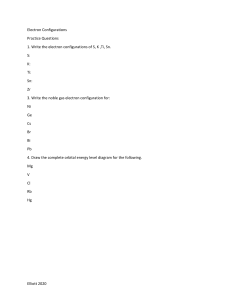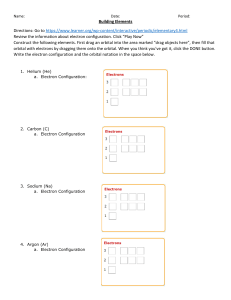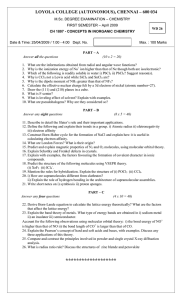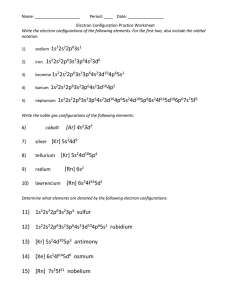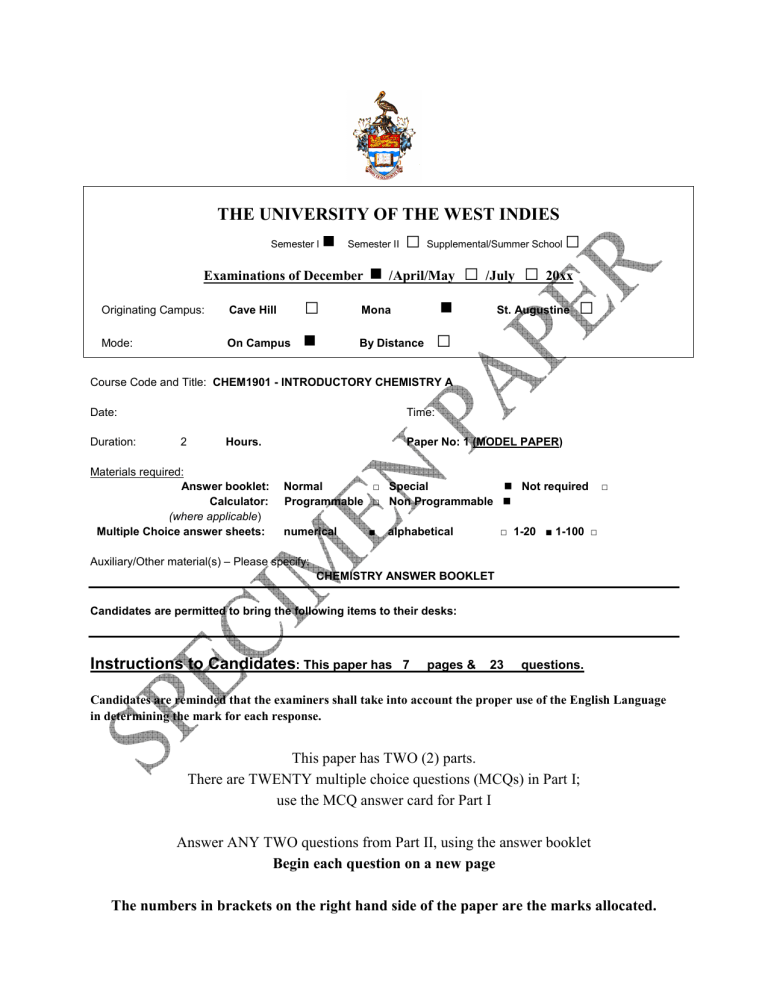
THE UIVERSITY OF THE WEST IDIES □ Supplemental/Summer School □ Examinations of December /April/May □ /July □ 20xx Originating Campus: Cave Hill □ Mona St. Augustine □ Mode: On Campus By Distance □ Semester l Semester II Course Code and Title: CHEM1901 - INTRODUCTORY CHEMISTRY A Date: Duration: Time: 2 Hours. Materials required: Answer booklet: Calculator: (where applicable) Multiple Choice answer sheets: Paper No: 1 (MODEL PAPER) Normal □ Special Not required Programmable □ Non Programmable numerical ■ alphabetical □ □ 1-20 ■ 1-100 □ Auxiliary/Other material(s) – Please specify: CHEMISTRY ANSWER BOOKLET Candidates are permitted to bring the following items to their desks: Instructions to Candidates: This paper has 7 pages & 23 questions. Candidates are reminded that the examiners shall take into account the proper use of the English Language in determining the mark for each response. This paper has TWO (2) parts. There are TWENTY multiple choice questions (MCQs) in Part I; use the MCQ answer card for Part I Answer ANY TWO questions from Part II, using the answer booklet Begin each question on a new page The numbers in brackets on the right hand side of the paper are the marks allocated. Part I (50 marks) Use the provided MCQ answer card for this part. Use a soft black pencil to shade in your ID number. Choose (by shading in) the best answer. 1. Which of the following combinations of quantum numbers (n , l, ml, ms) for an electron is OT permissible? A. (5, 3, -3, ½) B (2, 0, 0, -½) C. (2, 3, -2, -½) D. (3, 2, 1, ½) 2. Calculate the energy (in Joules) of the photon absorbed when an electron in the hydrogen atom is excited from n = 3 to n = 5. A. 4.575 x 10-19 B. 1.059 x 10-19 C. 2.179 x 10-18 D. 1.550 x 10-19 3. The mean radius of an orbital on the hydrogen atom is given by the expression: 2 l (l + 1) n a o <r>n,l = 1 + 12 1 − . Calculate the mean radius of the 2s orbital. n 2 Z 25 27 A. B. C. 5 ao D. 6 ao ao ao 2 2 4. Which of the following statements is correct? A. The radial wavefunction (Rn,l) is positive everywhere for the 2s orbital. B. The square of the radial wavefunction (R2n,l) is positive for one lobe and negative for the other for the 2p orbital. C. The sign of the radial wave function for the 3s orbital changes twice. D. The radial wavefunction (Rn,l) for the 1s orbital is positive on one side of the nucleus and negative on the other side. 5. A wavefunction, or orbital, is known to have 1 radial node and 1 angular node. Identify the wavefunction by stating its principal quantum number and an appropriate letter. A. 2s 6. B. 2p C. 3s D. 3p In the orbital approximation, as applied to the ground state helium atom, which of the following statements is true? A. The electron-electron repulsive forces are ignored. B. Each electron experiences an average force due to the other electron and the nucleus. C. The attractive force of the nucleus on one electron is considered negligible. 7. D. One electron is removed from the atom resulting in a He+ ion. Calculate the uncertainty in the momentum (in kg m s-1) of an electron if the uncertainty in its position is 2.00 x 10-12 m. A. 2.11 x 10-22 B. 7.37 x 10-21 C. 1.33 x 10-21 D. 2.64 x 10-23 8. Which of the following statements is/are CORRECT? (i) The selectivity of an analytical method can be represented by the slope of the calibration curve (ii) The limit of quantification of an analytical method is calculated as three times the standard deviation of a blank value (iii) The accuracy of an analytical method is represented by the proximity of the obtained result to the correct result A. (i) and (iii) B. (ii) and (iii) C. (iii) only D. All are correct 9. In the titration of 25.00 mL of 0.075 M NaOH with 0.100 M hydrochloric acid, what is the pH of the titration mixture after the equivalence point has been exceeded by 2.5 mL? A. 2.05 B. 1.93 C. 1.88 D. 0.071 10. What is the pH of a 0.045 M solution of sodium acetate (Kb = 5.71 x 10-10)? A. 9.24 B. 5.30 C. 4.76 D. 8.70 11. Compound X has properties that make it suitable to be used as an indicator in neutralization titrations. If its dissociation constant Ka = 1.32 x 10-4, in which of the following types of titrations (titrand / titrant) is Compound X most likely to be useful? A. Weak acid / weak base B. Weak acid / strong base C. Weak base / strong acid D. All of the above 12. A sample of grain (5.291 g) was analysed by the Kjeldahl Method. The liberated ammonia was passed through 50.00 mL of 0.250 M hydrochloric acid solution, and back titration with 0.100 M sodium hydroxide gave an equivalence volume of 14.35 mL. What is the nitrogen content (in w/w percent) of the grain sample? A. 3.31 B. 0.38 C. 2.93 D. 0.15 13. In the titration of 10.0 mL of 0.175 M sodium hydroxide with 0.125 M hydrochloric acid, what is the pH in the titration vessel after the addition of 13.0 mL of titrant? A. 12.0 B. 2.26 C. 12.8 D. 11.7 14. Estimate the dissociation constant Ka of the weak acid titrand that generated the curve below after titration with 0.050 M sodium hydroxide: A. B. C. D. 1.9 x 10-5 1.0 x 10-9 9.8 x 10-6 5.1 x 10-5 15. For a CH2O molecule, what is the internal energy predicted to be based on the classical approach for a solution to molecular energies? (R = the universal gas constant). A. 3.5 R B. 9 R C. 1.5 R D. 12 R 16. What is the moment of inertia for 1H79Br, if the bond length is 147 pm? (1 amu = 1.66 × 10-27 kg) A. 2.41 × 10-37 kg B. 3.95 × 10-64 kg m2 D. 3.54 × 10-47 kg m2 C. 1.64 × 10-27 kg m2 17. For an electron in a theoretical one-dimensional box of length 200 pm, what is the lowest translational energy? (me = 9.109 × 10-31 kg and Planck’s constant = 6.626 × 10-34 J s) A. 1.51 × 10-18 J B. 1.51 × 10-42 J C. 1.20 × 10-17 J D. 2.27 × 1015 J 18. For an electron in a theoretical one-dimensional box of length 200 pm, what is the separation between the two lowest energy levels? (me = 9.109 × 10-31 kg and Planck’s constant = 6.626 × 10-34 J s) A. 1.51 × 10-18 J B. 2.51 × 10-21 J C. 4.52 × 10-18 J D. 9.04 × 10-28 J 19. What is Zeff for a 3s electron in Mg? A. 3.20 B. 9.15 20. C. 2.85 D. 4.85 Given the following data, what is the bond energy (in kJ/mol) of the Cl-F bond? χF = 4.0 χCl = 3.09 Bond energy of Cl2 = 229 kJ/mol Bond energy of F2 = 150 kJ/mol A. 189.5 B. 269.1 C. 169.5 D. 289.1 Part II (50 marks) Answer ANY TWO (2) questions in this part ATOMIC STRUCTURE 1. (a) The energy of electronic transitions in a hydrogen-like species can be determined from the following expression: 1 1 E n = hcR 2 − 2 z 2 n1 n2 i) Define all the terms in the expression, and state what is meant by the term ‘hydrogen-like’. ii) Calculate the energy (in joules) of the photon ejected from the He+ ion when an electron falls from n = 5 to n = 2. Determine the wavelength (in nm) of the photon and state the region of the electromagnetic spectrum (4) in which it would be found. (Assume R = 109,700 cm-1). (b) i) (8) What do you understand by the Heisenberg Uncertainty Principle, which can be expressed as: ∆x.∆v ≥ h / 2m . ii) Consider a colloidal particle with a mass of 6.2 x 10-16 kg. Suppose that its position is measured to within 1.0 nm, which is about the resolving power of an electron microscope. Calculate the uncertainty in the velocity and comment on the significance of the result. (5) (8) AALYTICAL CHEMISTRY 2. (a) Calculate the molar absorptivity of a compound at 430 nm if a solution produced by dissolving 0.25 g in 250 mL of water records an absorbance of 0.326 at 430 nm when measured in a 2.0 cm cell. The relative molecular mass of the compound is 246. (5) (b) Name two sources of electromagnetic radiation used in instruments for molecular absorption spectroscopy and BRIEFLY explain how they work, including any common modifications for improved performance. Include clearly labeled diagrams with your answer. (10) (c) A sample of grain (0.5348 g) was digested on an electrical heating mantle with 50 mL of concentrated H2SO4 and a concentrated solution of NaOH was then added. The NH3 formed was collected by bubbling through 30.00 mL of 0.045 M HCl and the excess HCl titrated to equivalence with 5.35 mL 0.0400 M NaOH. Calculate the percent nitrogen in the grain sample. (7) (d) What name is given to the analytical procedure described in Part (c) and what are some of its potential limitations? (3) PHYSICAL CHEMISTRY 3. (a) The energy levels of a rigid rotor are given by: EJ = J ( J + 1)h 2 8π 2 I i) Define the terms EJ, J, h, and I, in the expression. ii) Starting from the Planck’s expression for energy, re-write the expression for the rotational energy in terms of wavenumber (m-1) and the rotational constant B (in m-1). (2) (4) iii) Hence, use the expression deduced in ii) to derive an expression for the transition: DEJ=J→J+1. (b) If a student wishes to determine the bond length of a non-polar molecule like hydrogen or nitrogen, suggest a spectroscopic technique that could be used to determine the bond length, once the identity of the gas is known. (c) i) Write an expression for the Boltzmann Distribution of molecular energies and define all the terms in the expression. (6) (2) (5) ii) Calculate the ratio of the molecules of 1H35Cl in the vibrational state v = 2 to the number of molecules in the ground state if the fundamental vibrational frequency is 8.96 x 1013 Hz at 30 oC. (6) ED OF QUESTIO PAPER
